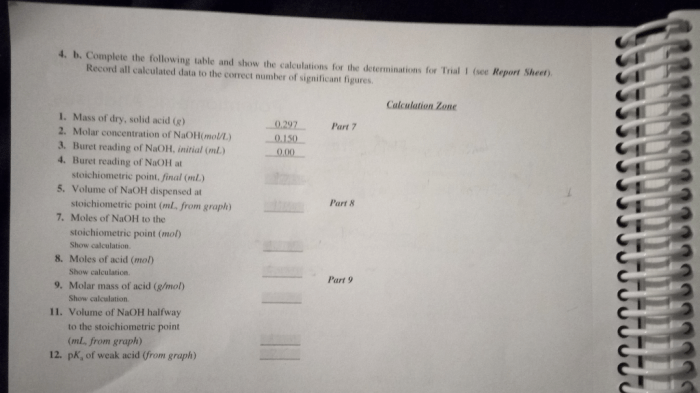Experiment 18 potentiometric analysis pre lab answers – Introducing Experiment 18 Potentiometric Analysis Pre-Lab Answers, a comprehensive resource that delves into the fascinating realm of potentiometric titration. This guide unravels the intricacies of this analytical technique, providing a solid foundation for students and researchers alike. Embark on a journey of discovery as we navigate the principles, procedures, and applications of potentiometric analysis.
Potentiometric titration, a powerful tool in analytical chemistry, enables the precise determination of unknown solution concentrations. By harnessing the principles of electrochemistry, this technique empowers us to analyze a wide range of samples, unraveling their chemical makeup with remarkable accuracy.
Join us as we explore the intricacies of potentiometric titration, unlocking the secrets of chemical analysis.
Experiment Overview
Experiment 18: Potentiometric Analysis is designed to introduce students to the principles and applications of potentiometric titrations. This experiment aims to determine the concentration of an unknown solution using a potentiometric titration and to understand the fundamental concepts of potentiometric titration, including the determination of the equivalence point using a potentiometric titration curve.
Potentiometric Titration Principles: Experiment 18 Potentiometric Analysis Pre Lab Answers

Potentiometric titration is a technique used to determine the concentration of an unknown solution by measuring the change in potential of an electrochemical cell during the titration. The equivalence point, where the moles of acid and base are equal, is determined by plotting the potential of the cell against the volume of titrant added.
The equivalence point can be accurately determined using a Gran plot, which is a plot of the second derivative of the titration curve against the volume of titrant added.
Experimental Setup and Equipment
Required Equipment, Experiment 18 potentiometric analysis pre lab answers
- Potentiometer
- Glass electrode
- Reference electrode
- Burette
- Magnetic stirrer
- Beakers
Experimental Setup
The experimental setup consists of a potentiometric cell, which includes a glass electrode and a reference electrode, connected to a potentiometer. The unknown solution is placed in a beaker and the titrant is added from a burette. The potential of the cell is measured and recorded as the titration progresses.
Reagents and Solutions

- Unknown solution
- Standard solution of known concentration
- Indicator solution (optional)
The concentrations and volumes of the reagents and solutions used will depend on the specific experiment being performed.
Titration Procedure
- Calibrate the potentiometer using standard solutions.
- Fill a burette with the standard solution.
- Transfer a known volume of the unknown solution to a beaker.
- Add a magnetic stirrer to the beaker and start stirring.
- Add the standard solution from the burette to the unknown solution in small increments, recording the potential of the cell after each addition.
- Continue adding the standard solution until the equivalence point is reached.
- Plot the potential of the cell against the volume of standard solution added.
Data Analysis
The concentration of the unknown solution can be calculated using the following equation:
“`Concentration of unknown = (Concentration of standard)
(Volume of standard added at equivalence point) / (Volume of unknown)
“`
The Gran plot can be used to accurately determine the equivalence point. The Gran plot is a plot of the second derivative of the titration curve against the volume of titrant added. The equivalence point is the point at which the second derivative is zero.
Error Analysis
There are several potential sources of error in potentiometric titrations, including:
- Errors in the calibration of the potentiometer
- Errors in the measurement of the volume of the standard solution
- Errors in the determination of the equivalence point
These errors can be minimized by carefully calibrating the potentiometer, using accurate measuring equipment, and using a Gran plot to accurately determine the equivalence point.
Query Resolution
What is the purpose of Experiment 18 Potentiometric Analysis?
Experiment 18 aims to provide a hands-on understanding of potentiometric titration, enabling students to determine the concentration of an unknown solution using a pH electrode.
What are the key principles of potentiometric titration?
Potentiometric titration relies on measuring the potential difference between an indicator electrode and a reference electrode immersed in the solution. The equivalence point is reached when the potential difference reaches a maximum or minimum, indicating the complete reaction between the analyte and the titrant.
How is the equivalence point determined using a potentiometric titration curve?
The equivalence point is graphically determined by plotting the potential difference against the volume of titrant added. The point of inflection on the curve corresponds to the equivalence point, where the rate of change in potential is greatest.